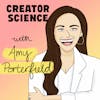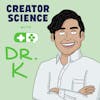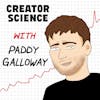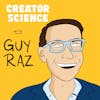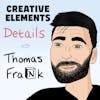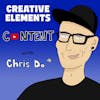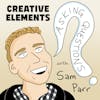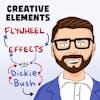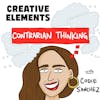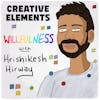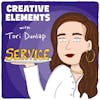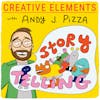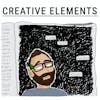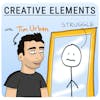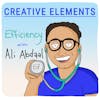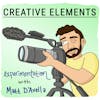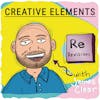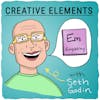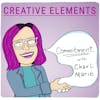
#64: Charli Marie Prangley - Building a YouTube Channel with 200K subscribers (on the side!)
Play EpisodeCharli Marie Prangley is the creator of the YouTube Channel CharlieMarieTV.
Charli Marie Prangley is the creator of the YouTube Channel CharlieMarieTV. Every week, she shares insights into life as a professional designer alongside tutorials and advice on design tools and concepts.
The channel has nearly 200,000 subscribers. But by day, Charli works as the Creative Director at ConvertKit while building her channel and podcast, Design Life, on the side.
New Zealand-born and half-British, Charli currently lives in Valencia, Spain. She's passionate about side projects and helping creatives improve their craft and process.
In this episode, we talk about how Charli balances her creative projects with her full-time job, hiring help, why she still isn’t interested in making her channel a full-time thing, and why commitment has helped her build her channel to nearly 200K subscribers.
Visit Charli Marie Prangley's website
Follow Charlie Marie Prangley on Twitter
Full transcript and show notes
***
ABOUT JAY CLOUSE
Subscribe to my weekly newsletter
Enroll in my course on podcasting, Podcast Like The Pros
***
LISTENER SUPPORT
Join our community on Facebook
Support this show through Buy Me A Coffee
***
SPONSORS
Try Podia and save 15% for life as a Creative Elements listener
Start your free trial of SavvyCal and get your first month free using promo code ELEMENTS
Get a free month of Blinkist Premium
Try Grammarly for free and save 20% on Grammarly Premium
***
PODGLOMERATE NETWORK
This show is a part of the Podglomerate network, a company that produces, distributes, and monetizes podcasts. We encourage you to visit the website and sign up for our newsletter for more information about our shows, launches, and events. For more information on how The Podglomerate treats data, please see our Privacy Policy.
Since you're listening to Creative Elements, we'd like to suggest you also try other Podglomerate shows surrounding entrepreneurship, business, and careers like Rocketship.fm and Freelance to Founder.
Learn more about your ad choices. Visit megaphone.fm/adchoices
Charli Marie Prangley 0:00
So for several years, I used to wake up at like 5:30am and edit videos before I would hop on the tube and commute to work. I even bought like the 11 inch MacBook so that I could edit videos on the tube on my way to work. That's how I made like all the things work together for a while there.
Jay Clouse 0:21
Welcome to Creative Elements, a show where we talk to your favorite creators and learn what it takes to make a living from your art and creativity. I'm your host Jay Clouse. Let's start the show.
Hello, my friend. Welcome back to another episode of Creative Elements. I want to give a quick thank you to Kelly V who recently left a review on Apple podcasts saying quote, I have been listening to creative elements since the first episode and was instantly hooked. No matter your level of business. This podcast has something to offer everyone. Jay's unique interview style sounds more like two friends having a conversation. And I particularly like the way he listens so attentively, then ask the exact questions I'm waiting to hear the answers to. You can tell his guests are comfortable because they are so generous with their replies. Jay is like a podcast ninja. Thanks so much, Jay. Look forward to every episode and quote. Thank you, Kelly for the kind review. If you haven't left a review yet on Apple podcasts, please consider doing so. And I might just read it here on the show. I also want to say thank you for bearing with me last week as I re aired a past episode with Ali Abdaal. It was a week of vacation for me and it was my birthday. It was exactly what I needed, actually. When my community Unreal Collective was acquired by Smart Passive Income early this year, I joined the company to lead their community team full time. But most of my own business continues to grow to this day. Every week, I'm putting time into this podcast, my newsletter, freelancing school and more. My independent business as a creator actually out earns my salary, which puts me into this position where I have to spend part time hours on my business that's generating full time income. And as you can imagine, that actually feels like I'm working two full time jobs at any given time. So the time off was very much appreciated. Anyway, I hope you listened to that episode with Ali because it truly is one of my favorites that I've made in an incredible primer on getting started on YouTube. And YouTube is where we will stay this week because I'm talking with an incredible creator named Charli Marie Prangley. But you may just know as Charli Marie.
Charli Marie Prangley 2:42
Hi, I'm Charli and I'm a designer. I work full time as the marketing design lead at a remote tech company. And I love getting to share the projects that I work on here on my YouTube channel. So hopefully you can learn a little something from my process. I'm from New Zealand, in case you're wondering about the accent. But right now I'm living in Spain, I also travel a bunch I love speaking at conferences, but you will also find me blogging regularly working from home days. Right here in my home office. My goal is to help creative professionals to increase their worth by improving their craft and their process. So on my channel, you'll find videos to help you do that. But you also just find insights into my life as a designer. If you like the sound of that, please hit the subscribe button and stick around. I upload every week. So hopefully I'll see you in the comment section of my next video. See you then.
Jay Clouse 3:39
That tech company that Charli mentioned in her welcome video is ConvertKit, an email marketing software and one of my favorite tools that I use every day. Charli is the creative director at ConvertKit. But her independent design channel known as Charli Marie TV, has 198,000 subscribers on YouTube with more than 12 million views. And she has a strong following on both Twitter and Instagram as well.
Charli Marie Prangley 4:04
YouTube came into play Oh, gosh, I can't even remember now it was about seven and a half, nearly eight years ago now probably. And that actually came about because I saw my sister making YouTube videos. And I saw her getting connected to this like little New Zealand YouTube community. And I was jealous. I wanted to be part of it. Basically, I started watching YouTube because I saw what she was doing. I was like, What is this people make videos of themselves just talking. And naturally as I do acid design on myself, I tried to find other designers on YouTube to watch. All I could find were people making tutorials. And I was like, Okay, this is great. But I don't really want to watch someone making something in Photoshop for fun. You know, I want to know about their life. I want to know about their career and what challenges they're facing and how they're solving them to sort of know what I could expect coming up in my own design career. And so that sort of sparked something in me that maybe I could make nice types of videos and maybe someone might be interested in hearing about my life as a designer.
Jay Clouse 5:06
And when Charli started her channel, she was actually talking a lot about her first business in e commerce store selling t shirts. The first video on her channel to this day is from 2013, talking about how she started her t shirt business, and it has 317,000 views.
Charli Marie Prangley 5:24
So I've been doing this for years now. And I haven't kept that up for the money because in all honesty, I don't really make that much from it. But I just love using this. So creative outlet, and I love making t shirts that I like to wear. But most of all, I just love that there's people all over the world who are wearing my designs, and that they thought that something I'd made was good enough for them to spend their money on. And that is just so cool. Oh, the T shirt business. One of my favorite things I've ever done, honestly. I started that when I was in university, I started designing lyric graphics of my favorite bands. I was a little pop punk emo kid making design graphics for the Fall Out Boy lyrics, posting them on Tumblr, and people really liked them. And I had a few people asked like, oh, how can I get this on so much? And I thought, Why I don't know. Let me try and figure that out. And so I dove in, I figured out how to print things onto t shirts. And I just started Yeah, selling t shirts to kids on Tumblr. And that's where my little t shirt company was born. And I ran it for about 10 years.
Jay Clouse 6:27
Gotta ask what were your most popular Fall Out Boy lyrics?
Charli Marie Prangley 6:31
Oh, okay, there was this one t shirt that said, breaking hearts has never looked so cool that the the drummer from Fall Out Boy actually like likes a photo of one. So that is my claim to fame.
Jay Clouse 6:43
In this episode, we talk about how Charli balances her creative projects with their full time job hiring help, why she still isn't interested in making her channel her full time thing. And why commitment has helped her build her channel to nearly 200,000 subscribers. I'd love to hear your thoughts on this episode. As you listen, you can find me on Twitter or Instagram @JayClouse tag me, say hello. And let me know that you're listening. And if you're not already in our listeners community on Facebook, I'd love for you to join. Links to all of that are in the show notes. But now, let's talk with Charli.
Charli Marie Prangley 7:24
You will notice a theme throughout probably most things I talk about that I'm I enjoy a lot of things. I'm passionate about a lot of things. And this came into play in my design degree as well, in that I couldn't pick a major for quite a long time, I sort of changed every year, it was always in design. But it was like which area of design I'm going to focus on. Don't make me pick I love them all. And for for a short time there. I was majoring in motion graphics. And so we were doing a lot of video editing as part of that as well as using After Effects to animate typography and, and things like that. So that's where I really learned to work with the timeline and that sort of thing.
Jay Clouse 7:58
I was looking at your website before we got on this this interview obviously. And I saw motion graphics in the typography of your name logo mark on your website. And I thought that is an incredible little touch. I wonder if she did that herself.
Charli Marie Prangley 8:12
She did not do that herself. No, these days I outsource those things that I'm I don't know I'm interested in but I'm perhaps not that skilled at anymore. And so Austin Saylor is my go to motion graphics person. Yeah.
Jay Clouse 8:28
I've definitely interacted with him on Twitter.
Charli Marie Prangley 8:30
Yeah. He's great.
Jay Clouse 8:31
Mental note to follow up with Austin. So you you started making videos on YouTube into your pleasant surprise, people started to care about the same things that you were thinking that you would care about to watch on YouTube? What were the signals that you were getting that that was true?
Charli Marie Prangley 8:43
I think I I was really excited when my design videos started getting more views than the videos I was making about fashion and beauty and the more like lifestyle content that was very popular on YouTube. Because I figured that if someone's gonna watch a video of me talking about a design project, or giving advice to designers, probably a sign that they're a designer themselves, or at least like interested in pursuing that route. And as those videos started to get more views, perhaps then the rest of my content was was getting, I was like, Okay, I can do this. I can like lean into this niche and just talk about design, because that's what I'm passionate about.
Jay Clouse 9:18
And what was the goal at this point?
Charli Marie Prangley 9:21
That's a really good question. I feel like my goal was to reach people living in New Zealand. It's like this little country at the bottom of the world. And it's very small, you know, everyone's quite spread out, as well as this slight little pockets of community, especially designed community here and there. But I have been like heavily online for a lot of my life, you know, like, teenage adult life, and I wanted to be a part of all the things that I was seeing, you know, all these people in London, talking about design and YouTube things people in the US as well. I just wanted to like be a part of that be a part of something really and That's what I was hoping that that YouTube would would elevate my presence to a level where I could be a part of things like that. And I also just thought about, okay myself signing out of my own design career, desperate to like, learn anything that I could about what it's really like to be a design professional, because you go through all this training, you go through years of design school, and then it's like, Okay, I'm out on the world. And I don't know what the heck I'm doing now. And I just really liked the idea of being able to advise those people who are perhaps a few few steps behind me on their career.
Jay Clouse 10:34
What were you doing professionally, Around this time,
Charli Marie Prangley 10:36
I was doing honestly what I've always been doing, which is being a designer on a marketing team at a tech company. That's been my yeah, my career path. I fell into it out of design school, I was a graphic designer on the marketing team for an electrical goods distributor, which was not the dream job. But actually, I discovered that I really loved it. And I didn't really want to pursue the agency life that I thought that I wanted to go after anymore. So yeah, then I've been pursuing marketing design roles in tech ever since. And so when I started YouTube, I was working at this New Zealand based tech company called Xero.
Jay Clouse 11:11
The accounting firm?
Charli Marie Prangley 11:11
Xero, the accounting firm, well, accounting software.
Jay Clouse 11:14
Small little company called Xero.
Charli Marie Prangley 11:16
Yes.
Jay Clouse 11:17
Back in, you know, mid 2010s. When this is happening, culturally, what was it like having your own side project next to the professional work? Did you feel like you had to shield that?
Charli Marie Prangley 11:29
Oh, yeah, big time. I was, like, a little embarrassed about it to start with. And I think that comes from being new at something, you know, it's always scary to do something new. And when you're sort of changing a little bit as a person or exploring something new, and the people in your life, I don't know, it's hard to introduce that to them. And I worried what my workmates would think especially because it's like, I know, it seems I worried to them, it would seem really like vapid and vain to be making videos on YouTube. And I wanted them to see me as a serious professional, you know, but I think that also comes into the the kiwi culture in New Zealand, there's this thing called tall poppy syndrome that you might have heard of.
Jay Clouse 12:09
I haven't please tell me.
Charli Marie Prangley 12:10
Let me tell you about tall poppy syndrome, because it's a something that afflicts like, Yeah, all Kiwis and Australians who I think a lot of the time, what it means is like, if there's a field of poppies, you want them all to be at the same level. So if any poppy sort of like rises up above the others, you cut it down so that the field looks the same, and is all at the same level. And so yeah, in in New Zealand culture, there's this big, big thing to not be like, I don't know, be bragging about yourself, and not being seen to be above other people or like stepping outside the mold too much. So that's very self deprecating, which, you know, I've been trying to break out of, and I think working with Americans has been helping me with that, honestly. But yeah, I was worried what people would think. No.
Jay Clouse 12:52
Americans love to be the tall Poppy.
Charli Marie Prangley 12:53
Oh, yeah. So I'm learning that from my American teammates now, which I really enjoy.
Jay Clouse 12:58
Well, it's interesting to hear that you're hesitant to talk about the YouTube channel or show the YouTube channel is not because you wanted to avoid giving this signal of like, Oh, I'm trying to do this full time. And I don't value the job. It was more so I don't want to stand out in and change the way you just see me. Yeah, the person.
Charli Marie Prangley 13:16
Yeah, that's the thing, because it's never been a consideration of mine really, to do YouTube full time. That has never really been the goal. It's crossed my mind many times, especially because it's something people often ask you, especially once I hit 100,000 subscribers on YouTube, people sort of see it as the path, right? Like, okay, you grow an audience big enough. Now, you do this full time, and you really lean into it. But for me, I need lots of different creative outlets in my life, to feel fulfilled and to enjoy my work. And working as a designer on a team is one of those things that I need. And so, for as long as that's true, I'm going to keep the full time job.
Jay Clouse 13:54
After a quick break, Charli and I talked about her motivation for growing her YouTube channel, and how she felt after hitting 100,000 subscribers right after this. Hey, welcome back. Charli told me earlier that she got started on YouTube because she liked the community. She wanted to be a part of that youtuber culture and have access to things that youtubers get access to. But I was curious to learn more about her motivation for the channel. She was clearly committed to consistently making new videos. But what was her goal?
Charli Marie Prangley 14:25
I think right from the start, I wanted that silver play button, which and I didn't think it was going to be possible honestly, for a designer in New Zealand like really? What 100,000 people want to subscribe to a channel like that, which is what you need before YouTube will send out a little plaque with a Yeah, Silver Play Button as we call it. But that was like the long term dream with YouTube for for a while was like, oh, it'd be so cool if I could get there. You know, and maybe that sounds bad, but it was mostly about the numbers and the like award mentality of it. But um, you know, I've always been the type of person who is He's wanting to get good grades and like do well with the things I do. And to me, that was a sign that something was working right. If enough people were watching the videos. So there was a lot of exciting things that happen this year. But probably the main one is that I hit 100,000 YouTube subscribers. That number still feels huge, and like unfathomable to me that that many people have clicked subscribe on the little red button on my channel. Amazing. And I honestly I pride when my youtube play button arrived, which seems ridiculous. But I know, when I first started YouTube, I always told myself that if I could get to 100,000 and get that silver play button, like that would be success for me, I would have done what I set out to do. So I just felt really cool. It was a really special moment.
Jay Clouse 15:51
And everybody has their Silver Play Button equivalent, you know, even if it's like, I want to be a managing director. Okay, you did it. And you got it. And you got the award. And now what so when when did that happen? For you?
Charli Marie Prangley 16:02
I think that happened for me in 2019 is when that happened. So it was it was a few years of hard work together.
Jay Clouse 16:12
six to seven years with my math holds. And this is pretty simple math. So I think it does. And now you're sitting at 195,000. So nearly double that in a third of the time. So once you hit that Silver Play Button milestone, where does your mind go next?
Charli Marie Prangley 16:27
Honestly, My mind went next into into sort of like check, like I've done that I've achieved that goal. And now I'm sort of using YouTube as the the main way I'm building my audience, but I'm got a lot of other things I want to do. So I've developed ways that producing videos can be sort of more on like a flywheel for me now I have editors that I outsource the editing of the videos to I have a Content Manager VA who will do the uploading. So that really all I'm having to do is well not all is make the video itself like record the footage, say what I want to say plan what I want to say. And then I have people to help me turn that into a YouTube video. So that I can focus on other things that I want to do which right now, the next dream I guess I don't want to tackle is writing a book, I really want to write a book that is like a guide to life. As a designer, I want it to be the kind of book that if you hear someone in your life wants to pursue this career, this is what you buy for them, or they buy for themselves to like learn what to expect and how to do it well. And then in like starting to follow that dream, I actually decided that before I write that book, that's going to be more of like a very targeted self help book, I want to write a book that's a more technical one about marketing design, which is my field of design in which is one that I feel is very like underrated in the design industry. Everyone wants to be a product designer and a UX designer. And those are seen as the valuable roles. And I know from my career that I can have a lot of value to a company as a marketing designer. And so I want to pass on everything that I've learned about that and how to do it well in a book. That's what I'm writing right now.
Jay Clouse 18:04
I wanted to go down this path and talk about Charli's book writing project. But first, we needed to take a quick step back. Because the last we heard, Charli was working as a marketing designer at the accounting software Xero. But today we know she's the creative director for ConvertKit. So I asked Charli, when and why she made that move.
Charli Marie Prangley 18:25
At Xero. I was there for about two years before realizing that I wanted to move overseas, which is something that I've always wanted to do throughout. I know just for as long as I can remember, I felt like in the future. I was going to live overseas, my family moved overseas when I was young. I grew up in a very small country called Brunei, which is on the island of Borneo. And so I guess like you know that that whole expat life was a part of me, and I wanted to do it as an adult. And so I made that happen in 2015. I think it was, I moved to London with my sister and the state at zero for about six months, but then moved on to a London based startup called Edited where I was, again, the marketing designer, because that's what I do. Still doing YouTube. And it was because of YouTube. But I was invited to speak at a conference called the Seanwes Conference, Sean McCabe who I don't know if you've heard of him, but he makes great content online has always been someone who has really inspired me and I joined his community. And he was pulling speakers for his conference from the community. And he invited me to speak about creating content with consistency.
Emcee 19:33
We're gonna jump right into it Our first speaker of the day, coming all the way over from London. She is a designer at a tech company in London. She has amassed over 30,000 subscribers on her YouTube channel, which is where she discusses and talks about creativity and design and professionalism within those things. She also has a podcast called design life, and she's here to talk with you about some really awesome things. So would you please welcome to stage Charli Prangley.
Charli Marie Prangley 20:07
I attribute my YouTube success to the fact that I uploaded a video every single week for five years. I took a little break after that. And my consistency has dropped off since then, that five years every single week, is what built up my audience there. So I gave a talk about that at the Seanwes conference, Nathan Berry, the founder and CEO of ConvertKit, was also giving a talk at that conference. And I guess he saw my talk or something, because after the conference that are wrapped up for the day, it was a mid day, he invited myself and some friends out to lunch was like, hey, should we go head to this little pizza place and get a slice? We ended up sitting there talking for several hours about design, about travel, content creation, all the things. And partway through the conversation, he goes to me. So Charli, have you ever considered working remotely for an email marketing software company? I was like, that's a weird question. What? And my friend was like, Charli, I'm pretty sure he's offering you a job. Turns out yeah, he kind of was. And so Nathan, and I chatted about that. And that's how I ended up with ConvertKit basically, was deciding that this would be a cool opportunity to work remotely for a company that is building software for creators, like it's I am the target audience. So it's, it's been a great fit.
Jay Clouse 21:26
Tell me about the state of or stage of the company ConvertKit at that time, and even the the state of the word creator, which you guys have really planted a flag behind, but has not always been a thing as it is today.
Charli Marie Prangley 21:38
Yeah. And even back then we would have said that ConvertKit is email marketing software for bloggers, is probably what Nathan would have said in that conversation to me. But the company was about 20 something people at the time, I think I might have been like employee number 24, or something like that. And I joined right before a team retreat, that it was the ConvertKit second team retreat, but the first like, you know, more properly, like structured one I guess, and got to meet everyone. And it was just a yeah, I felt at home straightaway, which was super cool.
Jay Clouse 22:13
Well, had to been nice. You know, given that he heard you at that talk, he knows that you have been creating content weekly for years.
Charli Marie Prangley 22:19
Yes.
Jay Clouse 22:19
And I assume when he made that offer, he wasn't asking you to stop doing that.
Charli Marie Prangley 22:24
Exactly.
Jay Clouse 22:25
Did you guys talk about that point, specifically?
Charli Marie Prangley 22:27
Yeah, definitely, we did. And I remember it being a point of contention maybe is the right way to say it, as part of a feedback session that we had, as at the first retreat that I went to, was my teammates who were very new. And usually, you know, they only know me for a month, but they were saying, I'm worried that Charli's gonna leave us because her channel is taken off, and like, you know, she's gonna want to do that instead. And so I really appreciate that at ConvertKit. We have a culture of calling things out like that, and just like not going unsaid, because I was able to try and dispel those thoughts. You know, it'd be like in reassure them that no, I want to be here. And yeah, as for ConvertKit, and embracing side projects, it's in our company handbook is not just like, we allow side projects. It's we embrace side projects. And so it's a very, like prevalent thing among the team.
Jay Clouse 23:19
Back in, you know, the late 2000s, you had the Tumblr page, you were selling t shirts. Now you're building a YouTube channel, are you monetizing the channel at all?
Charli Marie Prangley 23:27
Yes, I was very excited to be able to get money from ads on YouTube to start with, before I started my channel, I like, I watched a lot of videos about how to start a YouTube channel and like how you earn money on YouTube, and all of that. And I was starting to learn about this concept of sponsorships and ad money and how the different and you know how that all works. But quite a few years ago, now, I actually turned ads off on my YouTube channel. So I did have them running for a few years. But I decided that if my goal was to help educate people, help people, you know, become better designers and their design career. And if they decide to click on my video, out of all of the videos, they could choose to watch on YouTube, I don't want them to have to wait 30 seconds to get into the content, you know, I want them to just be able to get into it straight away. I feel like I kind of got this mentality from Sean McCabe because it's something he talked about a lot is the providing value and that it will come back to you eventually, you know, it's like building an audience karma in a way in that I provide this value and I trust that someday someone's gonna remember that if not consciously, because you might not notice that there was no ads on my videos. But subconsciously, I've been giving you a good like value driven experience.
Jay Clouse 24:42
Totally, totally buy into this love the phrase audience karma. There's, there's a cynical part of me that is like, yes, but you build up audience karma so that someday there is a payoff.
Charli Marie Prangley 24:52
Yes.
Jay Clouse 24:52
So you have to be thinking about that to some degree. And what does that what does that feel like to you at this point, even if you haven't fully decided.
Charli Marie Prangley 24:57
Yeah, so to me, it looks Like having my audience support me through the projects that I do. So like I hope when I watch this book that I'm writing about marketing design that my audience buy it in droves. Ideally, please, audience, and I released a digital font last year was was really fun, my first digital product to Yeah, have people support that and buying that was cool. But that's I think the way that I would, I would prefer to monetize content going forward. I've also really been enjoying partnering with companies like Figma, and Webflow on sponsorships on my videos, but also hosting content on their channels as well. It's been a fun new like, yeah, content creation thing to explore.
Jay Clouse 25:39
Obviously, you've you've had to have considered things like courses, paid courses. Yes, you're doing so much educational content?
Charli Marie Prangley 25:45
Yes.
Jay Clouse 25:46
Already. Where's your mindset on that?
Charli Marie Prangley 25:47
My mindset on courses is, it feels like a lot of work. I don't ever want to do anything, unless it can be top quality. You know, like, the marketing design book I'm writing right now is going to be an E book. And I read things about people writing ebooks from just putting together a bunch of blog posts and like, boom, there's your ebook, you can start selling. But to me, I'm like, No, I want to write like the best book on marketing design that's ever been written. Like, that's the pressure I put on myself, I guess. But it's, that's what's fun for me, too, is making things at that quality level. And yeah, right now, I have to say no to making a course, even though I'd love to, because I know that I have limited time doing all this stuff on the side of a full time job. And I can't do everything. And so I've got to go with the one that I care the most about in this moment and sort of table the other ideas for later. So the course is on the later table at the moment.
Jay Clouse 26:39
Oh, man. Well, I would love to convince you to do that. And that, especially given the process you've already put in place. It's it's not that much work.
Charli Marie Prangley 26:47
You say that. But you see, I would make it a lot of work.
Jay Clouse 26:50
Okay, well, I'd be interested to hear like what type of effects you'd want to put onto it. Because when I hear it's a lot of work, I think like you mean from scripting or shooting, but it sounds like you must be planning some different types of touches to make it stand out. If you're thinking that there's work about that,
Charli Marie Prangley 27:05
I would think, yeah, both of those things. It's more like the course planning, like how do I make a course that teaches people everything they need to know about you know, whatever. I've been going through the book process, I feel like that will feed into a course about marketing design someday, possibly, because I've already been figuring out like, what is it that people actually need to know? And what is my structure for teaching it? I think another thing for me is that I'm not interested at all in teaching software. Like I don't want to do a Webflow course or Figma course, like the technical side of design isn't what I'm interested in teaching. I like teaching the like the strategy, the thinking and more of the quote, unquote, soft skills that I think are actually very important. We shouldn't call them soft.
Jay Clouse 27:44
When we come back, Charli and I talked about how she balances her creator business with a full time job. And a little later, we talked about how she began building a team to support her channel. So stick around, and we'll be right back. Welcome back to my conversation with Charli Prangley of Charli Marie TV. Besides Charli's thriving YouTube channel, she also produces a podcast, a newsletter, and has even started streaming on Twitch. That's ignoring the book project she mentioned just a moment ago, juggling this many creative projects is something that I'm all too familiar with. So I asked Charli, how she prioritizes whichever projects she feeds first.
Charli Marie Prangley 28:25
That's a great question. The YouTube channel because it's my main audience driver is the one that I feel like always feed First, I want to try and have a video up every week. But I've in recent years, especially I feel like over the past year become like a little more lenient on myself when I'm when I need to be in noticing my energy levels and my drive and not trying to force content when it's not happening. But I'm also a believer in the fact that motivation comes from like doing the work, you don't like get motivated, then do the work, you have to like, do some things, and then you get motivated to continue. So I don't know, it's like a balance there in taking care of mental health and all of that. Yeah, feed YouTube feed a weekly newsletter called the marketing design dispatch, that's something that I really want to have going, especially in the lead up to my book. So that's pretty important at the moment, one podcast I have with a co host. So that really helps feed that because it's like, if I don't do that I'm letting someone else down. So it's not just myself, I'm accountable to. And that's for the rest. It's sort of just whenever I feel like it is the approach that I take with the content.
Jay Clouse 29:28
You're clearly building a very holistic ecosystem for yourself as a creator. And again, there's like a part of me that's a little bit cynical, that thinks why build such a holistic ecosystem, if not to aspire to do it full time someday. So can you talk to me a little bit more about your mindset around? Well, if YouTube's a main channel, why not just 100% YouTube all the time.
Charli Marie Prangley 29:52
Right? Because I would get bored. quite honestly. It wouldn't be feeding everything that I want to be doing if I was just doing YouTube full time. I feel like uh, one of the great things about my channel is actually that I'm sharing the real projects that I'm working on in my real design job. I'm not just doing like a demo project to show you how to use some software, I'm showing you how I tackle this very real problem. For a real company, I could definitely see myself in future like if I decided I wanted more control over my time would be probably the main reason I would go, you know, work full time for myself. I would freelance probably, like consult with other companies on designing their their websites, because I need to be solving those real design problems to feel fulfilled at the moment. And that might change in the future, who knows I'm open to it. But for now, that's a part of what I need as a person and as a creative.
Jay Clouse 30:42
What types of guardrails do you put up for when you're investing your own time into your own work alongside the full time job.
Charli Marie Prangley 30:49
So from several years, I used to wake up at like 5:30am and edit videos before I would hop on the tube and commute to work. I even bought like the 11 inch MacBook so that I could edit videos on the tube on my way to work. That's how I made like, all the things work together for a while there. I don't know, as you get older, and perhaps as these things get more settles and it becomes less of a hustle and more of like a always on thing. I have definitely changed a lot the ways that I work. Hiring help has been a huge way that I don't have to invest as much of my own time into making everything run. So that's been well worth the investment for me. And I now tend to do a little bit each morning, like maybe an hour or two on my own stuff before I get into my quote unquote, day job stuff. Because I work for a US based company. I live in Spain. Now we didn't get to that yet. And so, you know, my workday is usually like I don't know, 10am to 7pm sort of thing to account for that that timezone crossover. So that's when I fit most of it in. And then usually one weekend day, I will spend on my own stuff. But like I said, I've been trying to really listen into, like lean in and in the times where I feel really motivated and driven. I'll spend the whole weekend working on things and getting ahead. And then the next weekend, maybe have a completely off as a break.
Jay Clouse 32:13
Yeah, well, I appreciate you answering these questions. I hope they don't seem too invasive. But I find myself in a very similar space where even my role, my stated expectation is actually 30 hours a week. And it's, you know it, there's a high trust environment whenever you want to do it. And so I find myself at times wanting to do some of my own work during the quote unquote, work week to protect some semblance of a weekend. But I really struggle with, like this self imposed guilt that comes with that. So I'm very interested to hear how other people manage their day. And when they put their own hours into that day.
Charli Marie Prangley 32:48
Yeah, maybe I felt a little bit of that to start with. But because I've been doing it for so long. Now this the split, I know that it all has to get done, or I'm going to be unhappy in my job if I'm not doing anything for my side hustles you know, and yeah, it is about trust to trust that when you're getting the work done, and I'm grateful to work for a company like as I'm sure you are where they trust you to do both of these things at once they're aware of it, and they know you're going to handle it.
Jay Clouse 33:14
You spoke that you have this support system around you now to help you with editing these different aspects of your business. When did that come into play, and why?
Charli Marie Prangley 33:23
So I started a Patreon A few years ago, this was one of the ways that I thought I might want to lean into monetizing my audience and you know, earning money as a creator for a while. And in my patreon group, I was posting a lot more honestly to them than perhaps I was publicly on social media. And I was talking about how I really struggle to edit videos that I had this big backlog of edit videos that I had filmed that needed editing, and I just couldn't summon the energy to edit them and get them out there. So I was apologizing for not having a video that week, basically, I think it's how it went. And one of my patrons, Nancy reached out and was like, hey, do you want help editing? Like, let me try and take this off your plate. Let me edit a video for you. Like, this is what I would charge. And we talked about it and I thought, Okay, this feels scary to let go of this because I feel like so much of the personality of the video is in the Edit. And you know, the decisions you make of which cut you include, etc. I wanted. I didn't know if I could let go of that. But being that she was a viewer, and she knew my video style and all of that I thought okay, well it couldn't hurt to give it a try. Right? I was making some money from videos I had I think had a regular channel sponsor at the time in Webflow. And so I thought, Okay, well I could invest that money I'm earning back into the making of the videos, and perhaps it would work out as like a zero sum. But then I could keep doing the videos at least so maybe it would be worth it. We tried it and it worked out great. And she's been editing my videos ever since. So for a couple of years now. I've since bought another editor to handle like more loads so that there's less chance of me missing a week. That sort of thing. And yeah, I've just learned to trust people basically trust people as part of the creative process.
Jay Clouse 35:06
I love that I love that it came from someone that was already in your ecosystem. I had a conversation with Jay Acunzo about this. And I was talking about this show, and how I could save five hours a week if I had an editor. But that's the creative part that feels like the most impactful investment of my own creative energy. And how can I possibly expect someone else to make the same editing decisions that I would but I guess, you know, when we, when we do our own work, even, we're wearing our own mask of like, the brand we build of us as like, what does it sound like when it sounds like Creative Elements? And someone else could probably figure that out or learn that?
Charli Marie Prangley 35:39
Yeah, because they've got all of these episodes that you've already reproduced as a, like a base and a template, honestly, to learn from.
Jay Clouse 35:46
When people think about hiring help, a big consideration is the investment in it. And is that a personal investment? Is that coming from the business? And with this being a side project? Does the business support the team at this point?
Charli Marie Prangley 35:58
Yeah, it does at the moment. So I actually, in my work at ConvertKit, I'm technically a contractor, because we don't have a company entity over in Europe.
Jay Clouse 36:07
Oh, interesting.
Charli Marie Prangley 36:07
And so I have my own company that all of my income comes through and sort of it's it's that ConvertKit work and all the side hustle worked together. And for a while, I would say the ConvertKit income was probably supporting some of the content income a little bit. But right now, I'm just about to publish my I write an income report each year. And in the past year, for my side hustles, this is going to be in pounds, so you can convert it for yourself in US dollars. I think I've earned about 40,000 pounds from just the side hustle stuff in the past year.
Jay Clouse 36:39
Amazing.
Charli Marie Prangley 36:39
And spent close to like 19,000 pounds on editing on software on, you know, all the other other things that go into running the business. So it's definitely paying for itself at this point, which is great.
Jay Clouse 36:52
Also very lean.
Charli Marie Prangley 36:53
Yeah. Well, I mean, there's there's not a whole lot of overhead, you know, most of the costs are in my contractors, in the video editors and the virtual assistant of which I actually have two one handles, the more the like, admin side of things in one handles the content, but it's Yeah, like I said, been a great investment for me, because of that time, it's given me back. And yeah, just basically taking off the plate, all the things that I would dread doing. Now someone else does for me instead. And I'm just there to oversee, which is nice.
Jay Clouse 37:23
Talk to me a little bit more about what commitment means to you, you know, I hear you say that you published a video every week for five years, I did the math, that's like 262 videos,
Charli Marie Prangley 37:33
That's a lot of videos.
Jay Clouse 37:34
That takes a lot of commitment. So what what drives you? Or what drove you to do that for five years, and still to this day?
Charli Marie Prangley 37:41
Yeah, I feel like I have always been someone who wants to follow my dreams, my favorite quote, as a kid, like, you know, when you would pick your favorite quote, in primary school, middle school, whatever was shoot for the moon, because even if you miss your land among the stars, and I just liked that idea of like, Okay, if you aim really high, even if you don't get there, you've still would have done something really great. And I feel like my parents always encouraged us to encourage like, the big dreaming side of things. And so I've always been a big dreamer. And really the the commitment side of things started with my move to London. That was something that I'd always wanted to do live overseas. And I realized one day that it wasn't gonna happen if I didn't make it happen. I had sort of floated through life, I feel like until that point, always been good in school and like, I don't know, got good grades. I worked hard and like tried hard for it. But, you know, it came fairly easily. My job as well, I got the first job that interviewed for when I entered the industry as a designer, got the job at zero, just from one interview wasn't interviewing anywhere else. And so that those sorts of things just felt like they happened, even though I made the choice to do them, go for them in the first place. But yeah, moving to London wasn't gonna happen unless I did some big things to get there. So I did I made that happen, made that move happen. And I feel like when I got there, that's when things really changed for me, not only with my side projects, and in business, and finances, and all of that, but just me as a person. I feel like I changed a lot when I moved to London, because it was this realization that okay, I did it, I achieved this dream that I had. And then there was a moment of like, what's next? Like, what's the next thing I want to work towards? And I feel like since then, I've just been going thing after thing, you know, like, what I want to work towards and what I want to do, and just believing in myself, that it might take a while. But if you put in the work, and if you commit to it, and no one no one else is gonna hold you to it. No one's gonna do it for you. You have to put in the work and get there.
Jay Clouse 39:40
How often do you create new commitments
Charli Marie Prangley 39:43
Too often. One of the things that I'm really trying to do more of and the reason why I haven't done a course yet, is I'm trying to learn to say no to myself a lot more. I have way more ideas than I do time to fulfill them. And so I guess part of part of this and part of growing as a creative, as person has been learning to figure out what I really want, and like, what's going to get me to where I want to be, you know, what should I be working on, that's going to have the most value to me long term. And that value might be like monetary value, it might be value in terms of like, personal fulfillment, as well. And that's what I try and use to make decisions. And sometimes I go on the wrong path. But you know, if it's doing it for yourself, you can course correct and go back and try again.
Jay Clouse 40:30
I feel like somebody people at the stage that you're at, and even where I'm at, you get here because you just say yes to so many things for a really long time. And then you realize that you need to start saying no, and you think that if you say no, three out of four times you're doing it, but even that one, yes, a quarter of the time can be such a massive commitment. And I've really underestimated that. Like, you gotta say no, virtually to everything.
Charli Marie Prangley 40:56
Yep, yeah. And I leave a lot of money on the table, honestly, with my business. Because of that I implemented this rule for myself in terms of video sponsorships, because my channel is like one of the biggest design channels out there, I get a lot of companies wanting to promote design related things on it. And I was spending a lot of time going through these emails and like figuring out okay, what would I charge for this type of sponsorship, I'd have to test the product and decide if it's something I really would recommend to my audience. And I know it's a lot of work. And so I just decided, Okay, you know, what, unless I have heard of the brand and already respected, and already use it, personally, I'm going to say no. And it does mean that there's some opportunities that could be cool, I'm sure that come my way that I just immediately decline. But it's just a waste of like brain space, to spend any more time on them.
Jay Clouse 41:43
It's really good for the audience karma we're talking about to them, that you're making those decisions on that decision matrix versus if you didn't have the full time job, for example, you would probably make a lot of decisions that were on the cusp for more questionable. Yeah. And that's, that's something that people underestimate when they think, well, I'm just gonna do this thing full time. That's, that's almost, you know, a hindrance to try to do things full time too early.
Charli Marie Prangley 42:03
Yeah. And that's probably one of the reasons why it wasn't something I considered early on was because I don't want to, I didn't wanna have to give that part of myself away in order to make money. And I know, there's lots of other ways to do it. And that many creators wouldn't feel that way about sponsorships. But yeah, I'm very, very picky when it comes to who I allow to sponsor a video, and I charge as much for it as I can. Whenever I do that, I think that that's, I like like, with having no adsense ads on my videos, I'm like, I know, this is gonna pay off sometime. Because I'm building the reputation as a designer and as a person online, like an internet person that people can respect hopefully.
Jay Clouse 42:42
Well I love this topic of commitments, because I think we've been sold the idea of habits as something that's this automated, well, once I make a decision, it just happens. And I feel like with creative work, there's no like creative habit, like it's always going to take willpower. Yeah. But then with commitments, also, it feels like there needs to be a regular practice of almost hygiene to kind of audit what you've committed to and what you'll continue to commit to. So when you do make a commitment, how seriously, do you take that off the baton? How often do you revisit that?
Charli Marie Prangley 43:11
I use the initial like excitement, that starts a commitment for me, until it runs out. Basically, I like lean well into that initial self motivation that excited me enough to make a commitment to this new thing in the first place. I'm never going to really, I feel like make a commitment in my side business to something that doesn't really excite me and fuel me initially. So feels like it's pretty easy to get started with that, and a lot harder to keep going once you reach the hardest stages. And I have hit burnout honestly, several times throughout this because I pushed the motivation too far at times. And I tried to keep going at that initial pace constantly. But it doesn't work that way. It's going to ebb and flow and you've got to move with it, or else it can't be a sustainable thing. And I keep having to learn that the hard way.
Jay Clouse 43:59
Well talk to me a little bit about Twitch that because I saw that's a fairly new commitment you've made. So what did the commitment to Twitch look like? Or what does that look like now?
Charli Marie Prangley 44:08
So honestly, it looks like no commitment at all to me. And that's kind of why I like it. I could have streamed on YouTube, right? Like I already had the audience there. It kind of makes no sense that I decided to stream on Twitch and start from zero. But streaming like going live was really scary to me. I don't know, I just I felt afraid of like, what if I don't know what to say in a moment, it's gonna be awkward and that scary. So I wanted to go live to less people and not to my whole like 190,000 subscription feeds that would have seen it on YouTube. So that's why I started on Twitch instead. And also I was enjoying using Twitch as a just as a person as well. But my approach to Twitch has been to stream whenever I feel like I have something that is worth streaming when it comes to showing my work. I like to stream as I'm building something as I'm designing something if I'm in the mood that day for company you know while I and company in the chat while I design while I work. And then if it's the weekend and I feel like playing a game, I'll stream while I play the game. But I'm not going to commit to any sort of schedule, which I know is going to limit my growth on Twitch. But it's one of those trade offs, right? It's like, okay, I could lean into this. And I could really grow on Twitch if I had a schedule and if I stuck to it, but it would suck the fun out of it and suck the energy away from all the other things that I want to work on. So it's not worth it. And it's like a trade off, I make and you have to make a lot of those as someone doing creative projects on the side.
Jay Clouse 45:31
So are you saying that you have no specific growth goals for Twitch?
Charli Marie Prangley 45:36
No, not really. I was excited to hit 1000 followers. I was like, anything below 1000 feels like why am I doing this? I don't know. Just when you've got that on all the other platforms. That's kind of what you want to see. But yeah, since I hit that, it's like cool. Every stream I do. I'm excited if more people join, that's I guess the goal is to like see that number go up over time instead of dropping. But there's no specific number that I want to hit the last stream I did. I remember being excited because I had an average of 34 viewers the whole time. I was like cool 34 people watch. We were on this thing constantly. And that's enough.
Jay Clouse 46:13
How much of a crossover do you think those 34 people or the 1000 plus people that subscribe your Twitch channel have with your YouTube channel.
Charli Marie Prangley 46:20
There's quite a crossover. But I've also seen some people find me on Twitch, which is cool, because another reason to stream on Twitch rather than YouTube is, I don't want to be a YouTuber, like I don't want that to be the thing that I'm known as is just YouTube is the main way that my audience is growing. But as you can tell, I do a lot of other creative things. And I didn't want to put all my eggs in the YouTube basket. And so it's cool to have that audience spread out a bit more. I was expecting the most people would come from my Twitter, from Instagram from YouTube, but a few people have found me on Twitch as well. So that's fun.
Jay Clouse 46:54
Do you ever see yourself using OBS to stream simultaneously on both?
Charli Marie Prangley 46:59
I have thought about it. And I don't know, maybe in the future, I could probably see doing that. But I also just loved Twitch, I love the community feel of it. It just feels like it's sort of how Twitter feels. To me Twitter feels like that place where if you get it, and if you enjoy it, you're a Twitter person and you get it and you enjoy it. And if you don't, if you just use Twitter to put a link out whenever you post an article, you're not really part of the community on there, right? Twitch, it feels the same way in that it feels like it's its own little community and in the way that people talk in the chat and things like that. But I haven't really experienced on YouTube, there's a lot more I don't know, people a lot more engaged. I feel on Twitch.
Jay Clouse 47:36
There's a real time aspect to it. I imagine the feedback loop. And the experience is just wildly different between posting a video and saying I hope this goes well and going live and saying I hopes people show up and then literally seeing them in real time.
Charli Marie Prangley 47:49
And then having them talking to you throughout or like helping you solve problems. I wouldn't have completed the last Webflow site I did if it wasn't for the people in the twitch chat. They were a huge help in like helping me solve bugs and yeah, no code challenges.
Jay Clouse 48:04
Well, one last question. I feel like I would be remiss not to say for folks who are listening to this who aspire to somewhere success on YouTube specifically, what advice would you give them if they're starting in 2021?
Charli Marie Prangley 48:15
Hmm, I think make the content that you feel is missing from YouTube, I think that you'll be most successful on YouTube, if you are a viewer of YouTube yourself in the niche that you're wanting to make content in. And if the content you choose to make is the stuff that you feel like, Oh, I wish someone else made this, maybe that could be what you make. That's been the approach I've always taken. And every time I do that with a video, I feel like it works out well for me. Because there's a lot of people in this world. And if you're wanting a piece of content or wanting training or you know entertainment on a particular thing, you can bet that there are other people out there who will want it too.
Jay Clouse 48:52
You know, in a lot of mediums, the advices figure out what you want to do and just get started. I think that probably works on YouTube as well. But I, again, the cynical part of me feels like there's a floor to the video quality you need for people to actually watch on YouTube. Is that something that I'm projecting or Is that true?
Charli Marie Prangley 49:11
I think it's true. Now. I think it wasn't true when I started back in 2013. But I think it is true now that it's it's so easy to make a good quality video, that if you don't make a good quality video, people will, they might watch that one but they're probably not going to subscribe and stick around for more. So it's absolutely worth paying attention to the thing is that anyone can make one if they've got a smartphone right? They all film in 4k pretty much now. But also it's in the editing for quality videos, I feel it's not just the the picture quality itself. It's in the editing. So like being tight with it, making sure that you're not wasting a second of someone's time, especially when you're getting started. No one's there really for your personality straight away. I'm sorry, that's the harsh truth, that therefore some value that you're going to provide. And so if you make it value packed, you'll earn the right to I don't know include more Have the more of your personality and the off the cuff and unplanned stuff later on.
Jay Clouse 50:12
It's always so fascinating to me talking with creators who are killing it, but aren't concerned with whether their creative business is their full time sole focus. I think we feel so much pressure to tell the world that we are independent and doing our thing full time to show that we are fully self employed. But why? If the work is fulfilling, if we enjoy our job, and we aren't limited in what we can do with our independent work, why make the lead? I love talking with creator like Charli with his mindset to normalize building creative businesses on the side. And that doesn't mean that they have to be small. If you will learn more about Charli you can visit her YouTube channel, Charli Marie TV or her website charlimarie.com. links to both are in the show notes. Thanks to Charli for being on the show. Thank you to Emily Clouse for making the artwork for this episode. Thanks to Nathan Todhunter for mixing the show, and Brian Skeel for creating our music. Did you know that every week I send an email with each episode to tell the story of how I booked the guest. People seem to love it. And you can get that email by subscribing to my newsletter at Jay clouse.com/emails. And link to that is also in the show notes. If you liked this episode, you can tweet @JayClouse and let me know and if you really want to say thank you, please leave a review on Apple podcasts. Thanks for listening, and I'll talk to you next week.
Most Popular Episodes
New to the show? Check out some of our most popular episodes.






